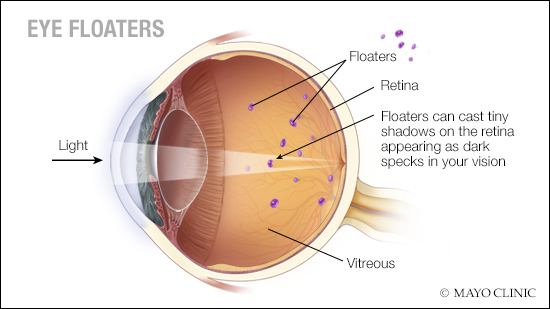-
Mayo Clinic Q and A: Most eye floaters caused by age-related changes

DEAR MAYO CLINIC: My dad mentioned to me that he has several dark spots and cobweblike strings that interfere with his vision. Is this something to be concerned about? What is needed to fix this condition?
ANSWER: Dark spots, such as those you describe, may be eye floaters. These black or gray specks, strings, or cobwebs typically drift about when you move your eyes and appear to dart away when you look at them directly. They may be most noticeable when you look at a plain, bright background, like the blue sky or a white wall.
People who need glasses to see distance, called being nearsighted, are more likely to get floaters. They also are more common in adults older than 50, as well as in people who’ve experienced eye trauma or inflammation inside the eye.
The presence of a few long-standing floaters usually is not a cause for concern. Most are caused by age-related changes that occur as the jellylike substance inside the eye, called vitreous, becomes more liquid. When this happens, tiny fibers within the vitreous tend to clump and can cast tiny shadows on the retina.

Although usually harmless, not all floaters are nonthreatening clumps of vitreous, so it is a good idea to have any new floaters examined with a dilated eye exam by an optometrist or an ophthalmologist. If he has not already done so, you should suggest to your father that he see a local eye specialist.
In the event that your father notices a sudden increase in floaters in one eye, he should seek immediate medical attention. In particular, prompt attention is needed if he sees light flashes or experiences a loss of peripheral vision. These changes may signal the presence of a retinal tear or a retinal detachment. If caught early, a retinal tear may be able to be treated with laser. If the tear has progressed to a retinal detachment, then surgery in the operating room is needed to repair the detachment. If left untreated, full detachment can lead to vision loss in the affected eye.
In rare situations an eye care professional may recommend surgical treatment. That can involve surgery to remove the vitreous, which is called a vitrectomy. However, there are risks, including bleeding and retinal tears, and the surgery may not remove all the floaters. Another treatment used infrequently for impaired vision caused by eye floaters is laser therapy. This treatment uses a laser to break up the floaters, making them less noticeable. Laser therapy risks still are not completely known.
As with any eye problem, if you are concerned about eye floaters, it is best to discuss your situation with an eye care professional, who will conduct a complete eye exam. By examining the back of the eyes and the vitreous, your eye care professional can determine the cause of the floaters. — Dr. Amir Khan, Ophthalmology, Mayo Clinic, Rochester, Minnesota
Related Articles







